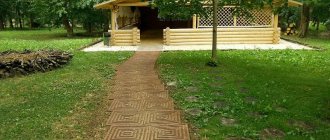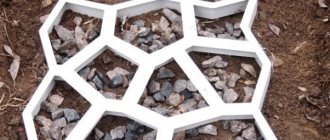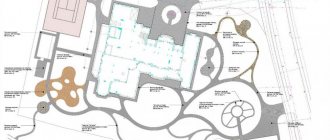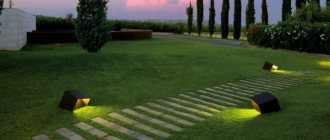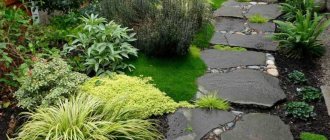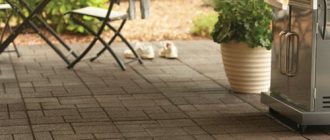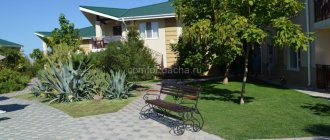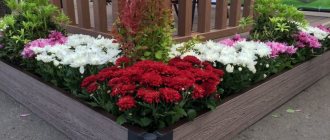Polymers, as the know-how of human thought, are gradually replacing natural materials in landscape design, imitating their appearance, but benefiting in terms of characteristics and price. And while people are already accustomed to plastic gnomes and swimming pools, plastic tiles for paths are used less often than paving stones or stones. It is being actively introduced into city squares and streets, but the average summer resident is still cautious or is simply not familiar with the technology for laying this material. Let's try to understand the nuances of constructing garden paths from different types of plastic tiles.
- 2 Laying modular tiles: assembly according to the type of designer
- 3 Polymer sand tiles: laying like paving stones
- 4 Decking: decent look + easy installation
What is modular covering
Modern industry produces flooring for outdoors and indoors in the form of separate modules (slabs) of various sizes and shapes. The modules are shaped in such a way that they can be laid in a single sheet without gaps or cracks. This is a modular coating. It resembles a children's puzzle and its elements are equipped with the same T-shaped locks.
Modular plastic covering for the street Source modulnye-poly.ru
The shape of the slab can be square, rectangular or figured, and the texture can be cellular, smooth or corrugated. Most often these are lightweight perforated plastic plates with through holes, which can be located in the longitudinal or transverse direction.
Various materials are used to manufacture modules. Garden paths made of plastic are very popular, although modules made of rubber, polymers, concrete or decking can also be found in many garden areas.
Rubberized coating for a playground Source obyava.ua
The modular coating is characterized by the following properties:
- The thickness of the slab is 1.5 cm.
- Size – 50 x 50 or 30 x 30 mm.
- The principle of the “groove-tenon” connection, that is, the two parts of the lock need to be inserted into one another until it clicks. Therefore, it is not difficult to install and dismantle.
- The use of corners, plugs, and transition parts that help mount a track of any unusual shape with a large number of bends.
- The presence of perforations that prevents the accumulation of moisture.
- The surface is corrugated, which prevents slipping, although in winter there is still a risk of slipping and injury.
The slabs must be installed on a solid or loose base. Installation is carried out similarly to laying stone or concrete tiles. The method depends on what the path is intended for and how long the owner of the site expects its validity to last.
Garden parquet Source laminatepol.ru
The first method is recommended to create a durable track with a long service life. They operate according to the following scheme:
- Use a shovel to remove the top layer of soil.
- Clean out the resulting trench and level it.
- Compact the surface of the trench.
- Cover with screenings or crushed stone.
- Lay a layer of geotextile to prevent grass from growing.
- Fill it with sand on top and compact it.
- Start laying the modules. On sloped areas, it is recommended to start from the highest point. Docking is done using a rubber hammer.
- After installation is complete, compact the tiles.
During operation, it is necessary to monitor the level of the track. If the difference exceeds 5 mm, the clutch will be incomplete. Modular coating is not used on a sloping area, and the surface must be absolutely flat. If there is a difference in height, you will need to make steps.
Covering with steps Source www.pinterest.com
If you plan to create a temporary path or a small area in the garden for garden furniture, the modular covering is laid directly on the soil surface without pre-treatment of the surface. This is convenient so that the modules can be assembled or moved to another location if necessary.
Another advantage of modular coating is that if a track is damaged, it is enough to replace the damaged module with another without affecting the rest.
Backyard decorated with paths Source www.gardener.ru
See also: Catalog of companies that specialize in landscaping work on sites.
Plot
0 votes
+
Vote for!
—
Vote against!
Plastic is an excellent option for decorating garden paths. This material is quite practical, inexpensive, and can easily withstand operating loads. However, to install it, you should familiarize yourself with the technological aspects of installing plastic tracks. Let's look at how to choose and lay plastic tiles correctly below.
Table of contents:
- Features and advantages of plastic garden paths
- How to lay a garden path using a modular board
- Technology for laying tiles for garden paths made of plastic: installation of polymer-sand materials
- How to properly lay a decking garden path
- DIY plastic garden paths
- DIY plastic garden paths
Features and advantages of plastic garden paths
Plastic products can imitate any texture, such as tiles, ceramics, marble, natural stone, metal, etc. Therefore, they are especially popular when performing finishing work. When choosing what material to decorate garden paths with, we recommend choosing plastic. This is explained by the following advantages of this material:
- plastic is a practical and easy-to-care material, it is easy to clean and does not accumulate dirt;
- plastic is resistant to moisture, temperature changes, and mechanical stress;
- there are a huge number of products that can imitate plastic, in addition, plastic tracks have an unlimited range of colors;
- the tiles have a corrugated coating that prevents slipping on it even in rainy weather;
- Plastic tiles are more affordable than stone or ceramic products.
Plastic finishing materials for paths most often take the form of tiles. At the same time, their composition necessarily contains polymer and other additives. Some products contain additional additives such as sawdust, quartz, etc. They are needed in order to improve certain qualities of the plastic. Products made from simple plastic are quite simple, but additional components can create a certain texture, color, and resistance to certain environmental factors.
Products made from pure plastic do not withstand frost well during use, and after several years of use they crumble. This tile plays the role of a temporary covering, which is installed in places where there is no need to deal with aesthetic design, for example, such as outbuildings.
Polymer products in combination with quartz sand are more durable and can withstand not only severe frosts, but also high mechanical stress in the form of a car and active human traffic.
However, the appearance of such tiles is unrealistic and resembles ordinary plastic. Such tiles cover paths located near the pool, pond, and in places of high humidity. However, for a garden path this is not the best option.
This tile is in harmony with the house if its facade is covered with siding. Wooden or stone houses are not complemented with such tiles.
Plastic tiles called decking have excellent attractiveness characteristics. It consists of wood flour and polymer additives. The appearance of the coating is similar to parquet boards; it is quite often installed on terraces.
The ratio of the two main components of a given tile depends on the manufacturer. The most attractive in texture are products containing only 25% polymer additives. However, such tiles are less resistant to moisture due to the presence of wood in them.
How to lay a garden path using a modular board
The modular version of plastic tiles is characterized by the presence of a perforated coating, which facilitates the free passage of dust and moisture through it. For joining with each other, such tiles are equipped with a locking connection. Therefore, installing modular tiles can be compared to assembling a children's construction set.
However, first of all, it is necessary to prepare a level base for laying the tiles. In order to secure the plastic tile modules, some manufacturers add additional fasteners. Thus, it is possible to increase the resistance of the coating to mechanical loads.
The base for laying the tiles must be perfectly flat, the maximum permissible differences are 0.5 cm. The option of laying a straight or rotary staircase is possible. The tile allows it to be mounted in any direction. The tiles are laid both on a concrete base and directly on the lawn.
Plastic garden paths photo:
Laying tiles on a lawn base takes 1-2 hours. However, experts recommend removing it from the soil in the winter. In order to avoid weeds from breaking through the tiles, before laying them, the soil is covered with woven materials.
If there is an old concrete path on the site, it is repaired using glue or concrete mortar, after which plastic tiles are laid. Please note that the only drawback of modular tiles is their instability to high mechanical loads, so vehicles cannot move on them.
Technology for laying tiles for garden paths made of plastic: installation of polymer-sand materials
An alternative option for paving stones is polymer tiles with the addition of quartz sand. Despite the susceptibility of paving stones to moisture, this tile does not have this disadvantage and tolerates any weather conditions well.
In order to install such tiles on the path, you should also equip an opening in the form of a trough, which consists of a sand and gravel cushion and curbs. Both crushed stone and sand-concrete mortar are laid on the concrete base. The choice of one material or another depends on the mechanical load on the base.
The operation of the tiles in winter directly depends on the quality of installation work. If the sand is poorly compacted, moisture entering it through the seams between the tiles will cause the paths to sag.
Concrete is not capable of transmitting moisture, so there is virtually no risk of subsidence. However, the absence of drainage holes will lead to the accumulation of moisture in the seams between the tiles.
The European method of laying plastic tiles in the garden involves performing the following actions:
- the fertile part, approximately 15-20 cm, is removed from the top of the soil;
- then the surface is leveled with tightly compacted sand;
- after this, slabs of extruded polystyrene foam are laid on the base;
- this insulation is not exposed to frost and moisture, so the structure of the tile remains warm all the time;
- in this case, the tiles are laid on a sand-cement mortar;
- Regular sand is used to fill the joints.
To ensure that the tile does not emit a specific odor at too high a temperature, it must be periodically watered with water.
How to properly lay a decking garden path
Decking is very similar in appearance to parquet boards. This finishing material has the form of a tile consisting of several planks connected to each other. To prevent moisture from accumulating in the tiles, small gaps are installed between the boards; their sizes vary from one to eight millimeters. At the same time, the material and type of gap are selected taking into account the amount of moisture contained in the soil.
There is decking with no gaps; it is more suitable for covering terraces, but not for arranging garden paths. To ensure good moisture removal and ventilation of the sub-tile space, a decking is made, consisting of two parts. The first part of the decking is a regular tile with small gaps between the boards, and the second is a lattice base in the form of a substrate on which the tiles are fixed and joined together.
The service life of such tiles is more than fifty years, since moisture is promptly removed to the base, thereby creating additional ventilation space.
The surface for laying the decking must be perfectly flat and hard, since the substrate in the soil or sand will simply sink and will not perform its intended functions.
In order to equip a plastic garden path from decking, you will need:
- concrete;
- boards;
- crushed stones;
- directly from the decking itself.
Most often, in the process of arranging garden paths, they are concreted before laying the decking. Thus, it is possible to increase the rigidity of the base and improve the performance characteristics of the coating itself. To decorate the edges of the path, an overlay plinth or decorative strip is used.
DIY plastic garden paths
It is not necessary to buy plastic tiles to make plastic paths. If you have a limited budget, you can build plastic paths from improvised materials, such as plastic bottles.
At the same time, there are three options for making tracks using different parts of bottles, such as:
- covers;
- segments;
- whole bottles.
During the work you will need a shovel, bucket, and scissors. To make a path from whole plastic bottles, you need to prepare a base. To do this, dig a trench 20 cm deep. Next, broken brick, stone or any construction waste is placed in it. After this, the surface is covered with sand and thoroughly compacted.
The bottles are carefully filled with soil or sand. Next, they are laid in a horizontal direction. To further compact plastic garden paths, you should place a board on them and walk along it for 10-15 minutes. A solution of cement and sand is used to fill the gaps between the bottles. After the solution has set, you can use the track for its intended purpose.
To make the path look interesting, you can place multi-colored pebbles, pieces of paper or foil in a container before pouring sand into it. To achieve harmony between the path and the overall exterior, we recommend decorating the front gardens, flower beds or trees in the garden with a fence made of plastic bottles.
Another option for homemade plastic covering for paths is to install a bottom made of plastic bottles. In this case, you should also prepare the base, as in the previous version. Next, you should use scissors and use them to cut the bottles 7-9 cm from the bottom.
In this case, the thickness of the sand layer increases and is about 15 cm. After thoroughly compacting and moistening the base, bottle bottoms are laid on it. It is possible to use colored bottles and lay out mosaic patterns from them.
To further compact the bottles on the path, you should walk along them for about 20 minutes. It is quite advisable to use the top parts of bottles as a greenhouse for plants.
The third method of making plastic garden paths in the country involves the use of plastic bottle caps. To do this, you should also prepare the base and place the plugs on it in the required order. Some craftsmen construct entire paintings from plastic bottle caps.
In this case, you can lay the plugs with the outer and inner sides. In the first case, it will be possible to obtain a flat base, and in the second, the surface will be corrugated.
DIY plastic garden paths
Another option for a plastic garden path is to use lawn gratings. With their help, it is possible to strengthen the lawn in order to walk on it without any consequences. In order to install this element, you should prepare the base, namely:
- select soil;
- fill the trench with gravel to a depth of 20 cm;
- lay geotextile material on it;
- fill the surface with sand 4 cm.
The thickness of the sand and gravel cushion depends on the purpose of the lawn. If it will be used only for walking, then 15-20 cm is enough. Otherwise, the value increases to a maximum of 50 cm.
There are lawn plastic gratings that are laid directly on the surface of the lawn, without any preparatory work. Laying such a coating is much more expensive.
You need to lay a lawn grate on the prepared surface. Fertile soil, grass seeds and fertilizer are used to fill the grates. Water this structure several times a day. Next, use the path for its intended purpose.
Rubber cover
It is considered one of the most popular means for arranging a garden path. Available in two varieties: 50 x 50 slabs 30 mm thick for laying on the ground, 25 mm thick for installation on a solid base. This is a very practical and modern option for arranging a garden path.
Rubber perfectly absorbs sound, does not require special care, is durable, does not shrink, and is easy to install.
Before laying it on soil without a solid base, it is thoroughly compacted, an 8-centimeter layer of crushed stone is poured on top, and a 5-7 cm layer of sand is placed on top of it. Connecting bushings are used for strength. The path turns out to be perfectly flat; along the edges it is fenced with a border made of rubber crumbs.
Convenient sidewalk Source blogpot.com.co
One of the advantages of such a track is that it can be easily removed and moved to another place. In addition, the coating is soft and has increased wear resistance.
25 cm rubber slabs require a solid base. It can be concrete, wood, asphalt, which must be pre-primed.
Square modules Source www.nicholsnassociates.com
Plastic border: features and use cases
A practical and cozy country plot is the dream of every owner; Landscape construction techniques help solve these two problems in an optimal way. One of the significant ways to improve the local area is zoning; it is carried out in different ways, often using the construction of garden paths.
Garden paths are the most practical way to implement a variety of design solutions; curb fences give them a neat appearance, and sometimes they can change them beyond recognition. Traditional curbs for paths, concrete, wood or brick, are chosen depending on the landscape features of the site. Plastic curb fences solve the same problems, but the visual result is different. The use of plastic borders, which create the effect of the path “embedded” in the vegetation, has become a favorite technique of landscape design professionals.
Curb stop as a decorative element Source moimirdizaina.ru
Plastic borders for garden paths can have different appearances. It can be flexible tape or durable, made in the form of piece parts of various shapes. In any case, it is adjacent to the track with a solid side, the opposite side serves for fixation. Plastic fencing is used not only to create neatly outlined paths. Such a fence can highlight the shape of a flower bed or lawn, limit the terrace, and prevent soil erosion. Plastic borders have proven their versatility; They are widely used for fencing children's sandboxes and playgrounds, blind areas around a residential building, and trees in the garden.
Plastic covering
These are multifunctional prefabricated plastic slabs, which are lightweight and low cost. Plastic tiles for paths in the countryside cost less than ceramic tiles, concrete, and vibro-pressed materials. And its light weight and compactness make it possible to transport it even in a personal car, loading and unloading it yourself.
Paths on the lawn Source utterlyhome.com
The plastic covering is easy to install and dismantle. Withstands any increased loads, and the service life exceeds 10 years.
Available in the form of standard square slabs measuring 30 x 30 or shaped slabs of different models and sizes. This allows you to use modules to cover any unevenness in the garden area.
Types of plastic coverings:
- Lattice modules. The easiest and most economical way to build a garden path. It is assembled like a children's construction set.
- Lawn lattice. It looks like a lattice structure, and its cells have different shapes. Ideal for strengthening the soil.
One of the varieties of garden parquet (decking) is also produced from plastic. It is a mixture of wood flour and polyvinyl chloride. It is often called “liquid wood” due to its external resemblance to wood, since the volume of wood in such material ranges from 50 to 80%.
Convenient approach to the recreation area Source www.1688.com
Types of tiles and their application
The most durable and wear-resistant paving materials are obtained by using quartz sand as a filler. Such tiles can be used not only for arranging pedestrian paths, but also for the passage of a passenger car. Sand-plastic tiles are not afraid of severe frosts and direct exposure to sunlight.
However, it is not possible to achieve a believable imitation of natural materials using such products. It will be clear that the coating is made of plastic. Sand-plastic tiles are very good for arranging swimming pools or other places with possible high humidity . The blind area around the building looks good if the facade is covered with siding, sandstone or other material of the same color range.
Polyurethane coating
Polymers are often used in landscape design. This is due to their increased environmental friendliness, safety and water permeability. To create a garden path, special tiles or a ready-made path made of rubber crumbs are produced.
Rubber modular tiles for the site Source ekometr.ru
It looks very aesthetically pleasing, in the form of a monolithic seamless structure that has a completely flat surface. The crumbs are obtained from old tires, then they are dyed in different colors. To increase strength when creating a track, crumbs of different sizes are mixed - from 1 to 3 mm.
The crumbs are mixed with polyurethane glue and applied to the prepared surface. The result is a finished path with a thickness of 6-13 mm, which in your area needs to be laid on a concrete base or directly on the ground. If the substrate is made of concrete, it is enough to lay the crumbs in a layer of 20 mm; on the ground you need a layer of at least 30 mm.
The service life of such a coating reaches 20 years if it is laid on a high-quality substrate, for example, concrete. The tape is glued to the base with polyurethane glue.
Covering on the playground Source profitpol.ru
Module material
Modular flooring can be made from different materials. Current trends encourage manufacturers to look towards recycling. Plastic is an ideal raw material for this .
Recycled polymers lose some of their technical properties. In addition, their use in some industries is prohibited due to sanitary standards.
The creation of floor coverings is the optimal niche for using recycled plastics. Modular coatings are not subject to such high requirements as products that need to be produced only from “primary” materials.
For the manufacture of floor modules, the following polymers are used :
- polyethylene;
- polyvinyl chloride;
- polypropylene;
- polystyrene
In addition, rubber modular coverings, which are made from recycled tires, are also widespread. We talked about them in this article.
Grass surface
This is a unique material that looks like lawn grass and has a bright green tint. Dirt-resistant bristle grass is made from latex-based polypropylene or polyethylene. It is used to cover lawns and paths. It is distinguished by softness and elasticity, which provide this coating with durability and strength.
Artificial turf Source www.belforddevelopments.co.uk
It allows water to pass through perfectly, which prevents it from stagnating. Resistant to temperature changes. The special strength makes it possible to cover sports grounds with such a coating.
The bristly coating allows you to clean the soles of shoes from adhering dirt or sand when walking. The height of the coating is 9 mm, for this reason moving on it is safe and comfortable.
Concrete tiles for garden plot Source yandex.ru
Video description
About the use of border tape in the garden in the following video:
"Wave"
A set of identical parts 9 cm high with a rounded top. Once installed (using plastic nails), the solid border takes on a wave-like appearance. The “wave” has a special protrusion at the bottom, thanks to which the lawn mower will mow the entire lawn without leaving any residue.
Border "Decorative brick"
The terracotta-colored material is a worthy replacement for classic brick. It has a height of 13 cm (the part protruding above the ground), is made from lightweight, high-strength polypropylene, and is not afraid of temperature changes. Such a fence looks like a series of ordinary bricks dug into the ground at an angle of 45°; it will help to separate the path from the plantings in an original way. The curb elements are fastened together using a tongue-and-groove pattern, each part is fixed in the ground with a fastening anchor. If the need arises, the fence can be disassembled and moved to another site without any problems.
Border “Wave” Source lestorg32.ru
"Garden designer"
The fencing elements are made in the form of half of a log split lengthwise, 15 or 21 cm high. The flexible connection of individual parts allows you to fence a sandbox, garden path or flower bed of any shape. Products are available in dark green, terracotta and brown.
Concrete covering
Concrete slabs for garden paths come in different models and shapes, although many gardeners often make them themselves. These are highly durable and practical elements with increased wear resistance.
During production, various pigments are added to the solution, so the garden path can be made of any desired color or even a picturesque mosaic of different colors can be created.
Concrete slabs are laid on sandy soil, so clay soil will need to be prepared first:
- Remove the top layer from the marked garden path, remove all roots and plants.
- Pour crushed stone in a layer of 10 cm, then sand 5-8 cm.
- Carefully compact each layer.
- Lay the tiles, press down firmly on top, and tap with a rubber hammer.
The finished path is covered with sand on top so that all the cracks are filled, and water is poured on top. You can lay concrete modules on cement-sand mortar. It is advisable to make borders along the edges.
Concrete modules of different sizes Source concrestonellc.com
Concrete slabs laid with large gaps that are seeded with lawn grass look very nice.
Design solution Source www.constructionandlandscape.com
Polymer sand paving slabs
Polymer sand modules serve as an excellent alternative to cement-sand tiles. In terms of wear resistance, they are far superior to building materials made of porcelain stoneware and concrete , and the material for their manufacture is more than affordable.
When producing paving slabs, recyclable materials do not require thorough pre-cleaning . Different types of packaging material can be used in production, such as PET bottles, canisters, etc.
The average price for polymer sand tiles in the Russian Federation is 55-160 rubles/piece. We talked in more detail about this type of flooring here.
Roll coating
Used as an alternative to tile covering, often used as a temporary option. It consists of a mixture of polymers and is sold in the form of rolls of different colors.
Rolled artificial turf Source www.indiamart.com
The rolls are easy to roll out and lay on any area, regardless of the presence of unevenness. Therefore, this is a convenient and inexpensive way to create a path for one season. It is advisable to lay the rolled tape on a substrate of crushed stone or gravel, especially for long-term use, since after rain it can sink into dirt.
At the end of the summer season, the roll is rolled up and sent to the barn until the beginning of next summer.
Anti-slip coating Source mo.tiu.ru
Production technology
Modules are produced by injection molding - hot plastic is fed under pressure into a mold and then cooled.
allows the use of both primary and secondary polymers as raw materials .
Since secondary raw materials are inferior in characteristics to primary ones, the finished product will also be significantly inferior in all respects. The way to avoid this is to dilute primary raw materials with secondary ones. This way you can obtain acceptable quality products at reasonable costs.
Injection molding is carried out using special equipment - an injection molding machine . Before starting the production of modules, the first step is to design and manufacture molds .
Plastic modules are manufactured as follows :
- raw materials are poured into the equipment bunker;
- polymers are melted and homogenized;
- molten plastic under pressure enters a special mold and fills it;
- the mold is cooling down
- the resulting product is confiscated.
Injection molding makes it possible to produce plastic flooring with high precision casting - the required dimensions and relief.
The resulting products are suitable for recycling.
Decking or garden parquet
Otherwise it is called anti-slip. O is available in the form of squares or quadrangles with hard or soft fastening. It is durable and reliable, as well as resistant to moisture and the aggressive influence of external factors. Garden parquet is made from various materials.
Wooden covering Source chaletwood.com
Negative qualities
With all its positive characteristics, plastic tiles have a number of disadvantages, namely:
- the appearance quickly deteriorates;
- fades in the sun;
Plastic paving slabs, with the exception of garden parquet, look rather primitive. It may simply not match the interior of the country cottage site.
The strength of such tiles is not so high that they can be driven on by a car. This may cause it to sag. As a result, the clamps will begin to deform. And the path, over time, will simply fall apart.
The plastic coating is not protected from aggressive chemicals. If, for example, acid is spilled on the track, serious damage to the plastic surface can occur.
Such tiles begin to slip a lot after getting wet. The most inexpensive structures, which contain 100% plastic, in other words, no organic inclusions, are recommended by professionals to be used only as a temporary coating.
Tree
Decking can be made of natural wood, varnished on top. This coating has the following properties:
- it is environmentally friendly
- harmless to humans;
- looks great on a site with a log house or wooden house;
- easy to clean;
- easy to install;
- absorbs heat;
- repels moisture, so the surface does not slip.
Such a path must be promptly painted, varnished in order to protect the surface from atmospheric factors, and treated with bug repellents. The bottom of the track should not come into contact with the ground, so it is installed on a substrate. The most popular types of wood for decking are pine, larch, and teak.
Flooring for the gazebo Source wp-decking.ru
Video description
About the garden border with a glow effect in the following video:
- When installing, you should follow the technology recommended by the manufacturer. The limits of application and methods of installation of products differ; compliance with the rules largely determines their reliability, durability and appearance.
- Plastic curbs should be in harmony with the material of the paths , the decoration of buildings and vegetation. Before purchasing, determine the installation location and the required quantity; You may need not one, but several types of borders of different configurations or colors.
- Installation of borders along the chosen path will be easier if you use a stretched fishing line and control the installation with a level.
- If the soil is dense or quite rocky, plastic anchors should be replaced with more durable metal fasteners (nails).
- On loose soil is much more convenient to create complex shapes ; bends are fixed with an additional anchor to avoid deformation and tears.
The site takes on a well-groomed appearance Source lestorg32.ru
Plastic
Plastic decking is a high-strength tile that consists of individual strips with ventilation gaps. The tiles are connected longitudinally or transversely. It is characterized by visual appeal, ease of installation, operation and maintenance. It is easy to install even without the involvement of specialists.
Evening lighting in modules Source gastrogrub.co.uk
Plastic decking:
- has a long service life;
- does not rot, is not exposed to insects;
- resistant to deformation, does not form cracks or chips;
- does not heat up in the sun, retains heat for a long time.
Subtleties of selection and installation
The properties of garden borders, strength and all-weather resistance, determine the range of their applications. Most plastic fences fix the boundaries of landscape elements; some can be used for arranging multi-tiered flower beds and plantings. To better understand the capabilities of the selected model, you should read the instructions included with the product. General recommendations for the purchase, installation and further operation of curbs are as follows:
- The composition of the plastic from which borders for garden paths are made includes special additives that allow the products to be used outdoors. The type of plastic is marked on the curb; You can find out about its properties and recyclability by using an Internet search .
- A practical solution for decorating a garden path made of stone, paving stones or paving slabs would be a border corner B-300.8,5.4,5 or any segmented version with supports . If the path is made of bulk material (for example, gravel), the best divider will be a “Country” curb. Flat ribbon borders are ideal for decorating flower beds.
Wood-polymer composite
Made from sawdust and a binder polymer. It consists of a wood-plastic plate that is attached to a substrate. It does not need to be rigidly attached to the base, so you can lay it yourself on the ground, concrete, or any other surface.
The best option for those who cannot afford to choose natural wood, but do not like plastic. Outwardly it resembles an expensive natural material, but is much stronger than wood, does not rot or collapse. Resistant to fungi and insects. Resistant to adverse environmental factors.
Decking has a variety of colors. It is laid on logs or on a surface of sand, gravel, earth, concrete. Start from any right angle, sections are secured in a checkerboard pattern. If necessary, the slabs can be cut.
Varieties of finishing elements
To arrange a plastic garden path, you can use both improvised (homemade) means and ready-made gratings or plastic modules. In the first case, you will have to show your imagination and spend a lot of time, since the first time the appearance of the finished product can be frankly disappointing. But it is possible to complete the track at low cost. With finished products everything is much simpler, you just need to decide on the color scheme and material, and you can start installation work, but from a financial point of view, it will be more expensive.
Paths can be made from various materials
Plastic modules are panels of different sizes. Most often we are talking about the size of 30x30 cm (the size directly depends on the shape). This type of arrangement of plastic paths allows you to hide all the flaws and unevenness of the site.
Pigments for painting tiles
Metal oxides are used to tint products:
- chromium oxide allows you to give the slabs a green color of different shades;
- titanium dioxide is necessary to create snow-white paving slabs;
- iron oxide allows you to tint blocks in coral, orange, terracotta, brown colors;
Color palette
Areas of use
Tile products made from polymers and sand components are in demand among owners of city houses, owners of summer cottages, professional builders, and so on. The areas of use of tiles are quite wide, for example:
- It is used for laying the local area . In this case, for example, garden paths, areas near gazebos and swimming pools may be subject to registration.
- As a complement to landscape design, various plant, flower and other compositions on the site.
- Like masonry at gas stations, car washes and service stations.
- For finishing the basement, steps and other elements of the house.
- As a covering for parks, shopping centers, playgrounds, enterprise areas and so on.
The areas of application are not limited to this. In this case, the boundaries are determined only by imagination, a sense of style and common sense.
Main characteristics
Technologies for the production of polymer-based boards make it possible to create durable and reliable products that are used in finishing, construction and site decoration. Polymer-sand paving slabs, which have a number of advantages, for example, over concrete products, compare favorably in this regard. The undeniable advantage of this material is that it is resistant to mechanical stress, while having a variety of beautiful variations and bright colors. These tiles combine comfort and quality.
One of the most noticeable characteristics of such tiles is the fact that no cement dust appears when they are laid. Any common types of installation do not lead to damage or cracking, which is due to its plasticity property. There are no difficulties in caring for the products, since they are easily washed with ordinary water without absorbing it, which allows you to not worry about reducing their shelf life.
In shape, these products have different shades and patterns, which not every tile can boast of. Polymer paving slabs, despite their considerable size, have a relatively low weight. But it can be used not only for the sidewalk - it is suitable, for example, for cladding external walls, laying borders or roofing (in the latter case, it is recommended to lay the tiles on a waterproofing layer on top of the supports).
Polymer sand tiles Garden and Paving 333x333x20-25-35 mm:
Drawing options:
| "9 squares" |
| Thickness, ±2mm: | 20 | 25 | 35 |
| Application, load: | Garden / Sidewalk Check-in of passenger cars | Garden / Sidewalk Arrival of cargo vehicles | Garden / Sidewalk Arrival of cargo vehicles |
| Requirement per 1 sq.m., pcs.: | 9 | 9 | 9 |
| Weight 1 pc. kg.: | 2,5 | 3,2 | 5 |
| Colors: | Chocolate, Cherry, Brick, Grey, Green, Black, Khaki, Blue, Light Blue. | ||
| Price Moscow region, Stupino : | 159 rub./piece* 153 RUR/piece* | 190 rub./piece* 180 rub./piece* | 225 rub./piece* 212 RUR/piece* |
| Price Moscow: | — | — | — |
| Price St. Petersburg “Baza Tosno”: | — | — | — |
| Price in Ryazan: | — | — | — |
| Price Tver (Bolshevikov St., 5-A): | — | — | — |
Benefits of use
laid polymer sand slab
The advantages of polymer sand slabs are:
- in wear resistance;
- in durability (30-50 years);
- low water absorption and resistance to sub-zero temperatures;
- high strength and ductility (the material does not crack or deform);
- in convenient transportation;
- in resistance to wear;
- in safe operation;
- in a small mass, ensuring convenient installation, including on interfloor ceilings and part of the roof;
- in low thermal conductivity;
- in anti-slip characteristics;
- in oil resistance and resistance to acidic environments;
- in processing that provides protection against mold and mildew.
- in maintainability;
- in a wide range of sizes, shades;
- in a wide operating temperature range (-60…+45°С).
- resistant to high loads (the blocks can withstand the impact of passenger cars and trucks).
